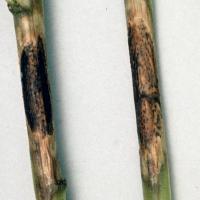Diagnosing phomopsis stem and pod blight in narrow-leafed lupins
Phomopsis stem and pod blight (Diaporthe toxica) occasionally causes yield losses, however the major impact of infection is the production of a mycotoxin (phomopsin) by the fungus as it grows in mature lupin stems. The toxin can cause sickness or death (lupinosis) in livestock if grazing of infected stubble is poorly managed.
What to look for
- Prematurely dying plants after pod set, particularly in parts of the paddock that are stressed by drought, frost, or herbicides.
Paddock
- Symptoms usually appear on senescing or dry lupin stems as dark lesions that bleach with age and contain black fruiting bodies.
- Stems weakened by lesions may snap causing plants to lodge.
- Lesions can develop on pods, the surface of green pods can become ‘slimy’ and mature pods may be shrivelled with dark discolouration. Dark lesions can also occur on the surface of relatively whole pods.
- Pod lesions can lead to seed infection, causing shrivelled or golden brown seeds. Cotyledons inside infected seeds remain green rather than yellow. This seed may contain mycotoxin
- Remnant stubble has bleached and patterned stem lesions that contain black fruiting bodies.
- Animals: Weight loss, listlessness and jaundiced eyes and gums.
Plant
What else could it be
| Condition | Similarities | Differences |
|---|---|---|
| Diagnosing grey mould in narrow-leafed lupins | Large stem lesions | Lesions are sunken often with grey fuzzy mould. No golden brown seed. |
| Diagnosing sclerotinia collar rot in narrow-leafed lupins | Stem lesions, premature death. | White cottony growth with embedded specks on stem instead of smooth patterned purple or grey lesions. No golden brown seed. |
| Diagnosing sclerotinia stem rot in narrow-leafed lupins and field peas | Stem lesions, premature death. | Stem and pod lesions are pale with whitish cottony growth and large black sclerotes inside the growth and the stem. No golden brown seed. |
Where did it come from?
- Spores released in winter from infected seed or fruiting bodies on stubble infect growing lupin plants but rarely cause lesions at this stage unless plants are stressed by drought, herbicide or frost. The infection remains latent as microscopic structures until the plant dies.
- In stressed plants, lesions form on stems and pods that cause premature death and infected seed.
- Moisture, such as summer rain, on the mature infected tissue allows the fungus to grow saprophytically producing the mycotoxin and also new fruiting bodies.
Management strategies

Resistant varieties
- There is no treatment, and yield losses are rare.
- Variety resistance is the most effective way of reducing phomopsis. All current varieties have moderate levels of resistance to both stem and pod infection.
- If weather conditions favour the pathogen (prolonged rainfall or high humidity in late spring and summer), stubble may still develop some toxicity requiring care with grazing, however usually current varieties do not produce highly toxic stubbles.
- Increasing breaks between lupin crops allows weathering and breakdown of infected stubble, reducing disease inoculum.
- Avoid feeding heavily infected seed to livestock.
See also
Where to go for expert help
Page last updated: Friday, 17 April 2015 - 9:08am




